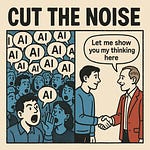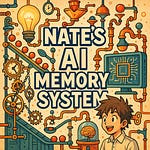If you're building anything with AI in 2025, these principles determine whether you succeed or fail. Full stop.
Maybe you're shipping AI features at your day job, prototyping on weekends, or running a team that's promised AI capabilities to customers. Maybe you're deep in the technical weeds or trying to understand why your AI project is harder than expected. Doesn't matter. Everyone touching AI needs to understand what's different about this technology—not the hype, but the concrete ways AI breaks every assumption we have about building software.
Right now, across the industry: Customer service bots that worked perfectly in demos are hallucinating policies that don't exist. AI analysts are losing their reasoning chains mid-calculation. Your traditional monitoring shows all green while customers report nonsense outputs.
These aren't edge cases. They're any given Tuesday building with AI.
This guide comes from my experience working across over 100 production AI builds. Here's what's in it:
Six Engineering Principles—the fundamental ways AI violates traditional software assumptions. Why your AI needs persistent memory. Why it will never be 100% predictable. Why your monitoring will lie to you. These aren't bugs to fix but realities to design around.
A Translation Guide—I decode what terms like "stateless" and "semantic monitoring" mean for your budget, timelines, and customer promises. You'll finally understand why that "simple" AI feature isn't simple.
The Hybrid Reality—You're not replacing traditional systems with AI. You're building a hybrid, and that's optimal, not a compromise. I'll show you exactly what stays traditional (authentication, billing) versus what goes AI (customer interactions, content analysis) and how to design the boundaries.
Your Practical Roadmap—What to do whether you're just starting, have pilots running, or are already hitting walls at scale. Specific patterns that work, plus the organizational changes that matter more than the technical ones.
The problem isn't that we don't know how to code. It's that AI violates principles so fundamental we don't realize we're assuming them. Every product decision, timeline, and capability promise rests on assumptions about how software behaves. With AI, those assumptions are wrong.
If you're an AI enthusiast or weekend builder: These principles explain why your local prototype breaks at scale. More importantly, they'll help you build things that don't.
If you're a vibe coder shipping AI features: You're probably discovering these principles through painful trial and error. This guide will save you the next six months of debugging.
If you're an engineer: You already know something's different about AI systems. This crystallizes exactly what and gives you language to explain it.
If you're in product or running a startup: These principles define what's actually possible versus what's wishful thinking. They're your reality check before the roadmap review.
If you're leadership or sales: This explains why AI projects take longer than expected and why the AI sometimes does that weird thing that loses customer trust.
So let's dig in.
Listen to this episode with a 7-day free trial
Subscribe to Nate’s Substack to listen to this post and get 7 days of free access to the full post archives.













